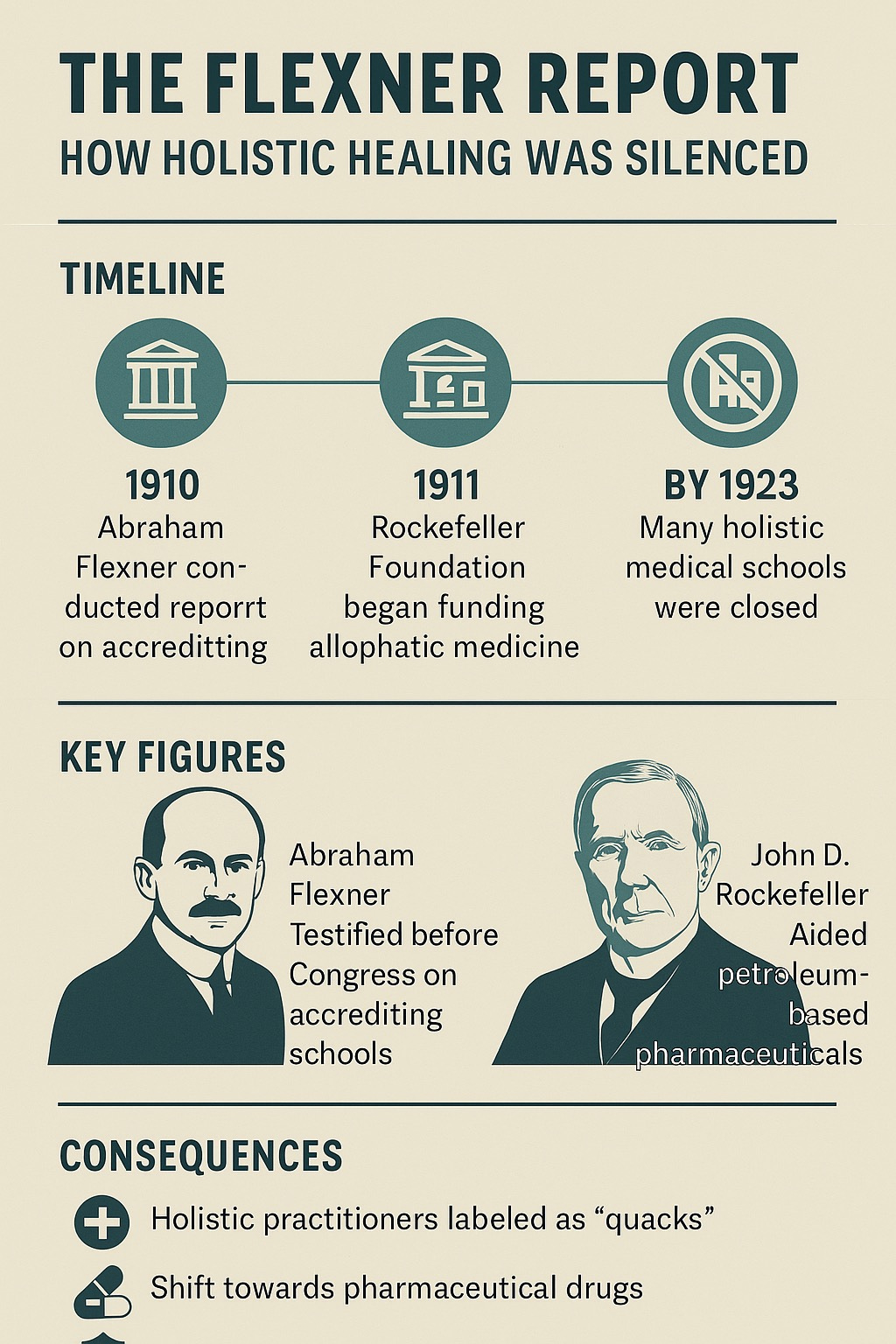The Flexner Report: How Holistic Healing Was Silenced/Discredited in the Name of Science and Mon$y
In the early 20th century, a seismic shift took place in American medicine—one that redefined the medical profession, reshaped healthcare education, and arguably sidelined centuries of holistic healing traditions. The catalyst for this transformation was the 1910 Flexner Report, a document that, while aimed at improving standards in medical education, had far-reaching consequences—many of them devastating for holistic practitioners.
Abraham Flexner and the Congressional Testimony
Abraham Flexner was an educator—not a physician—tasked by the Carnegie Foundation and commissioned by the American Medical Association (AMA) to evaluate the quality of medical schools across the United States and Canada. In front of Congress, Flexner testified that many of these institutions were unscientific, inconsistent, and even dangerous to public health. He advocated for a standardized, science-based medical education system.
His recommendations emphasized laboratory research, strict licensing standards, and an adherence to the “germ theory” of disease, prioritizing pharmacological intervention over traditional and natural methods of healing.
The Impact on Holistic Medicine
At the time, there were many medical schools teaching alternative and traditional healing methods—such as naturopathy, homeopathy, chiropractic, herbalism, and indigenous medicine. Many of these were rooted in centuries-old healing systems. But following the Flexner Report:
Over 50% of all medical schools in the U.S. were closed, disproportionately those that taught holistic or non-allopathic medicine.
Black and female medical colleges were also shut down, further narrowing diversity in medical thought and practitioners.
Holistic practitioners were increasingly labeled as “quacks” or “unscientific,” and their practices were criminalized or marginalized.
The Role of Rockefeller and Big Oil
This radical shift in medicine did not occur in a vacuum. Around the same time, John D. Rockefeller, head of Standard Oil, was expanding his empire into petroleum-based pharmaceuticals. Through the Rockefeller Foundation, massive financial support was funneled into universities and medical schools—but only those that adhered to the allopathic model promoted by the Flexner Report.
It’s widely speculated—and supported by some historians and researchers—that the Rockefellers and Rothschilds, with massive influence over industry and education, used the Flexner Report as a tool to centralize and control medicine. The Rockefellers, already dominating the oil industry, saw the opportunity to convert petrochemicals into pharmaceutical drugs, creating the modern pharmaceutical industry.
In this light, the Flexner Report served as a vehicle to shift medicine from natural healing to patented, synthetic drugs—produced, regulated, and profited on by a small elite.
Accreditation as a Gatekeeping Tool
One of Flexner’s key recommendations was the establishment of strict accreditation standards for medical schools. While this improved consistency and hygiene in some areas, it also became a powerful gatekeeping mechanism. Only schools that followed the AMA-approved allopathic model would be accredited. Others were denied legitimacy, funding, and graduates were barred from licensure.
This effectively removed competition from traditional healing schools and created a monopoly of thought and treatment in medicine.
The Legacy Today
Today, most people grow up unaware of this turning point in history. We’ve inherited a system that regards synthetic pharmaceutical intervention as the default and dismisses ancient herbal wisdom, dietary healing, energy medicine, and many forms of holistic care as “unproven.”
However, the tides are slowly turning. Growing interest in integrative medicine, functional medicine, and natural healing points to a resurgence of what was nearly erased.
Conclusion
The Flexner Report, presented as a reform in the name of public safety and scientific advancement, was in many ways a political maneuver that eliminated holistic competition, centralized medical education, and birthed the pharmaceutical-industrial complex.
Understanding this history is crucial—not to demonize all modern medicine, but to recognize that health freedom, diverse healing approaches, and patient-centered care were casualties of a corporate-driven agenda.
As the public becomes more educated and discerning, there is hope for a reconciliation between the wisdom of the past and the advancements of the present—a medicine that honors both science and the body’s natural ability to heal.




